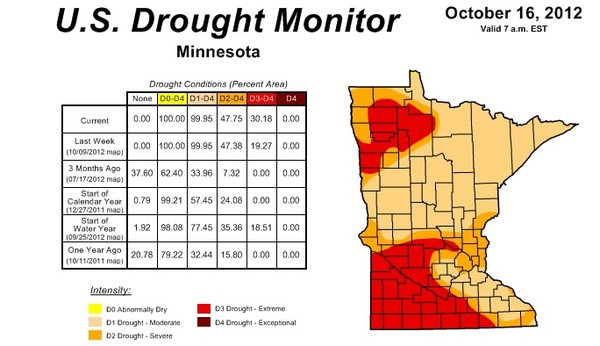 It looks like the lack of rain is taking its toll on Minnesota lakes and rivers. According to the state climatology office, the last three months near zero precipitation is making most of Minnesota rainfall totals rank at or below the lowest on record. The DNR is also calling for water conservation across the state and is giving examples of how the drought conditions are affecting the State’s water levels:
It looks like the lack of rain is taking its toll on Minnesota lakes and rivers. According to the state climatology office, the last three months near zero precipitation is making most of Minnesota rainfall totals rank at or below the lowest on record. The DNR is also calling for water conservation across the state and is giving examples of how the drought conditions are affecting the State’s water levels:
- Water conflicts between users and uses are emerging in more places.
- Nearly one-half of the state is in severe drought or worse; severe drought is considered a one in 10-year event; extreme drought is considered a one in 20-year event.
- The extent and geographic distribution of the current drought is rivaling the extreme drought event of the late 1980s.
- Large areas of Minnesota have missed the equivalent of two summertime month’s worth of rain.
- Soil moisture levels are at or below all-time low values for the end of September.
- White Bear Lake’s water level has hit its lowest point on record.
- It is a dire situation going into the 2013 growing season.
For Lake Minnetonka, the current water level is a foot lower than it was a few months ago, and about 18 inches lower than at the beginning of summer, according to the DNR and an article from the Lake Minnetonka Patch. The lowest recorded water level ever recorded for Lake Minnetonka was in 1937, putting it about 6 feet lower than the recent October 2012 measurement.
You might wonder why Lake Minnetonka water levels might matter so much to the Twin Cities. The answer is simple – it is the beginning of the Minnehaha Creek watershed which encompasses “181 square miles that drain into the Minnehaha Creek and ultimately the Mississippi River. The watershed includes Minnehaha Creek, Lake Minnetonka, the Minneapolis Chain of Lakes, and Minnehaha Falls and there are eight major creeks, 129 lakes, and thousands of wetlands” affected by decreasing water levels. Low levels in the watershed mean a low Mississippi River, which can already be seen in areas down to the Gulf of Mexico.
While levels are not at record lows, it is a concern for the upcoming years if we don’t get rain soon. If the winter brings no snow, conditions will only worsen in the spring and make for a very dry 2013. Maybe it’s time to start the rain dance.

